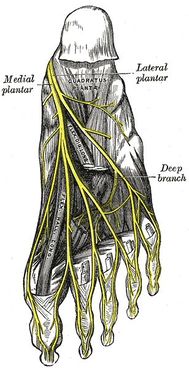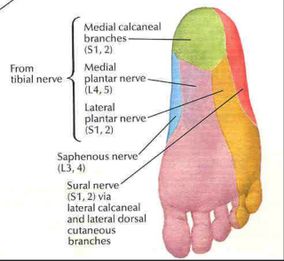Lateral Plantar Nerve
Top Contributors - Elena Ferrero Vila, Leana Louw and Wendy Snyders
Description[edit | edit source]
The lateral plantar nerve or the external plantar nerve (latin: nervus plantaris lateralis), it enters the sole of the foot by passing deep to the proximal insertion of the abductor hallucis muscle. It continues across the sole anteriorly and laterally, between the digitorum brevis and quadratus plantae muscles innervating both of these muscles. Then, close to the 5th metatarsal head, it will divide into the deep and superficial branches[1]
Root[edit | edit source]
The lateral plantar nerve is a terminal branch of the tibial nerve.
Branches[edit | edit source]
- The superficial branch of the lateral plantar nerve splits into:
- The lateral proper plantar digital nerve, which innervates the skin of the lateral aspects of the 5th toe and a branch for innervating the flexor digiti quinti brevis.
- The common plantar digital nerve which communicates with the 3rd common branch of the medial plantar nerve and divides into the two proper digital nerves of the 4th and 5th toe.
- The deep branch of the lateral plantar nerve; is a motor branch and it innervates from the second to the fourth lubricates, the adductor hallucis, and supplies all the interossei (apart from the ones on the 4th metatarsal space innervated by the superficial branch).
Function[edit | edit source]
Motor[edit | edit source]
It is a motor nerve that innervates all the intrinsic muscles from the sole with the exception of abductor hallucis, flexor digitorum brevis, the flexor hallucis brevis, and the first lumbrical muscle innervated by the medial plantar nerve.
Sensory[edit | edit source]
It also a sensory nerve that provides sensory information from the two anterior thirds of the lateral sole of the foot, as well as the plantar surfaces for the 5th and half of the 4th toe.
Clinical relevance[edit | edit source]
The clinical relevance, the entrapment of the lateral plantar nerve first branch, also known as Baxter's nerve has symptoms similar to plantar fasciitis and tarsal tunnel syndrome including pain at the inside of the ankle and heel. Baxter's Neuropathy, is the entrapment of the first branch of the lateral plantar nerve, which innervates the abductor digiti quinti muscle. Baxter's Neuropathy is a painful condition that can lead to chronic heel pain.[2]
Assessment[edit | edit source]
- The symptoms usually pain at the medial aspect of the heel that exponentially increases with loadbearing.
- Symptoms tend to get worse as the day goes on, or appearing after prolonged activity.
- Radiating pain may be present when the nerve is palpated.
- There is maximal tenderness at the medial border of the heel where the entrapment occurs – usually around the origin and deep to the abductor hallucis. This may create radiating and/or burning pain laterally across the plantar foot.
- There is a positive Phalen’s test (invert and plantarflex the foot passively). This compresses the nerve due to the narrowing of the porta pedis
- There may be weak abduction of the fifth toe. This is due to the abductor digiti minimi muscle.
- There may be a positive Tinel’s sign. Paresthesias may be reproduced with tapping over the nerve beneath the abductor hallucis muscle.
- In chronic cases, patients may have diminished sensation in the lateral plantar foot.
Treatment[edit | edit source]
- Taping and/or orthotics to control overpronation.
- Stretching of the soleus and gastrocnemius muscles.
- Soft tissue therapy to the plantar fascia and foot intrinsic.
- Non-steroidal anti-inflammatory medication (NSAIDs).
- Strengthening exercises for the foot intrinsics.
- Non-conservative treatment:[5]
Endoscopic decompression of the first branch of the lateral plantar nerve
References[edit | edit source]
- ↑ Develi S.Trifurcation of the tibial nerve within the tarsal tunnel.Surg Radiol Anat 2018;40.5: 529-532.
- ↑ 2.0 2.1 Thomas, Christensen JC, Kravitz SR, Mendicino RW, Schuberth JM, Vanore JV, et all. The diagnosis and treatment of heel pain: a clinical practice guideline-revision . J Foot Ankle Surg 2010;49(3 Suppl):S1–S19.
- ↑ 3.0 3.1 Ferkel E, Davis WH, Ellington JK Entrapment neuropathies of the foot and ankle. Clin sports med 2015; 34(4): 791-801.
- ↑ Davis PF, Severud E, Baxter DE. Painful heel syndrome: results of nonoperative treatment. Foot Ankle Int. 1994;15(10):531-535.
- ↑ Lui TH. Endoscopic decompression of the first branch of the lateral plantar nerve. Arch Orthop Trauma Surg 2007;127(9): 859-861.








